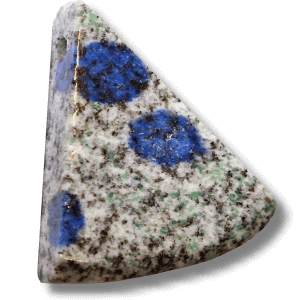_____________________
The rock that we are presenting to you looks as if it had been decorated with blue inkblots. It was presented to us as "azurite granite". It is reported that it is found at the foot of the K2 mountain in northern Pakistan. Therefore it is also offered under the trade name "K2".
The structures we saw by using our microscope was similar to that of gneiss. Quartz, biotite and feldspar crystals and a weakly pronounced, layered structure were easily recognizable. In addition, small grains of a green mineral and these strange blue spots are readily visible with the naked eye.
The carbonate test with 10% diluted hydrochloric acid showed an unspecific reaction pattern. The green mineral reacted promptly to the acid, classifying it as malachite. In the rest of the rock a weak but irregular reaction could be observed, no matter whether these domains were green, blue or colorless. It seemed as if carbonatic minerals had penetrated the whole stone.
The occurrence of basic copper carbonates such as azurite and malachite (which are typical for sedimentary deposits) in a metamorphic gneiss is highly unusual. Therefore, we decided to clarify the mineral composition by means of X-ray diffraction analysis (EDX).
X-ray diffraction analysis (EDX)
With the help of EDX, the individual minerals in a rock can be determined very well. Quartz, feldspar (orthoclase/microcline), plagioclase (albite) and mica (biotite) were found as the main constituents. This mineral composition fits very well with the microscopic appearance of this granular gneiss. The macroscopically visible blue domains could be identified as azurite, as an impregnation of the preexisting gneiss.
By using a scanning electron microscope we tried to find out something about the genesis of this unusual rock
Scanning Electron Microscopy (SEM)
Under the SEM, an extremely thin coating (about 1 - 2 µm) of elemental copper was detected in the grain boundaries of the intense blue areas. In other analyses traces of sulphur were found, which may be a remnant of decomposed sulphide minerals.
Azurite occurs both in the form of veins and layers only 2-5µm thick in open cracks and at the grain boundaries of the quartz and feldspar crystals and in form of small (5-20µm) pockets in plagioclase feldspars.
Conclusion
Azurite-gneiss is a metamorphic rock. After its formation it came into contact with CO2-rich hydrothermal fluids. It is conceivable that any grains or nests of copper sulphides (e.g. chalcopyrite), that may have been originaly present, were converted to copper carbonates and elemental copper. Azurite could only be formed where sufficient copper was available. It is possible that grains of copper sulphite of different sizes produced zones of azurite around the grains. When the sulphide grain was completely decomposed, the new formation of azurite stopped. This is the reason for the different size and intensity of the blue spots.




